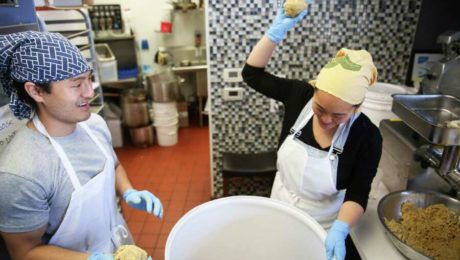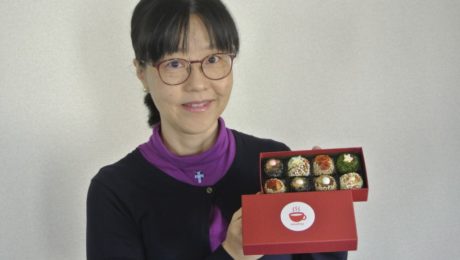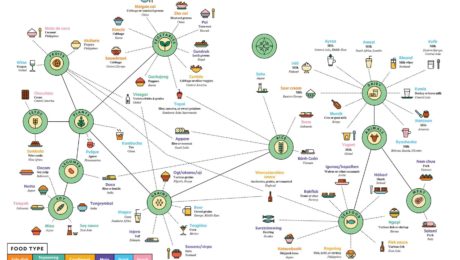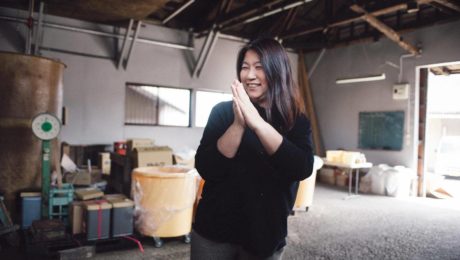Scaling Artisanal Fermentation
Fungi fermenter Shared Cultures was the featured cover story in a recent Food & Wine section of the San Francisco Chronicle. Company co-owners Elena Hsu and Kevin Gondo make small-batch fermented soy sauce, miso, and sauces and marinades using koji and wild, foraged mushrooms.
The article calls Shared Cultures “the darling of the Bay Area food scene.” It details how they use traditional techniques with unexpected ingredients, like a shoyu with quinoa and lentils, a miso with cacao nib and a koji salt with leek flowers.
Hsu and Gondo also open up about the challenges of scaling artisanal fermentation. They are the only employees at the companys and can’t keep up with the demand. Their ferments require a lot of time, some fermenting for eight months in a closet-size room in their rented commercial kitchen. They note that it is too expensive to rent or purchase their own warehouse in the Bay Area.
Multiple California chefs use Shared Cultures products for an added umami punch. Hsu encourages home cooks to experiment with their products, too, “You don’t have to have a $300 tasting menu to try these flavors,” she says. “You can be the chef.”
Read more (San Francisco Chronicle)
- Published in Business, Food & Flavor
KojiCon Highlights
Over 1,100 koji experts and enthusiasts from 63 different countries and 49 states gathered virtually for this year’s KojiCon. Koji, the mold-based ferment prevalent in East Asia and used to make soy sauce, sake and miso, is becoming more common in restaurants and in home cooking around the world.
The second annual KojiCon wrapped-up March 6. It was created by the Yellow Farmhouse Education Center, a nonprofit organization based at Stone Acres Farm in Stonington, Connecticut. The center focuses on food and farm education through educational opportunities. Rich Shih, co-author of Koji Alchemy, who helps organize the event, joined speakers like Sandor Katz, Misti Norris, Takashi Sato, Hiroko Shimbo, Kirsten Shockey, Jeremy Umansky and David Zilber and Mara King speaking on the theme of “Changing Food for Good.”
“It opens our eyes to possibilities beyond koji, within the Asian approach towards fermentation, primarily mold-based,” Shih said of the conference. “We want you to discover that, through fermentation, maybe just adding a little bit of salt or drying it or you know of course adding these mold-based ferments that we’re talking about, you can create amazing flavors.”
Pictured are Jen Rothman and Eric Dawson of Yellow Farmhouse, Shih, Irene Yoo of Yoo Eating, King and Umansky.
Though the conference is over, tickets to watch the recordings are still available at: https://kojicon.org/
- Published in Food & Flavor
Preserving Japan’s Miso Culture
A Japanese public-relations-exec-turned-chef has developed a unique product — Miso Drops, individually-sized servings of stock. She felt it was difficult for an individual customer to use miso from traditional breweries because they only ship products weighing at least 500 grams. Her drops weigh around 26 grams.
Entrepreneur Motomi Takahashi, “alarmed by the gradual disappearance of small-scale miso breweries that have been a key part of Japan’s tradition of fermented foods,” created the soybean paste balls using traditional methods. And, different from the large factories that mass-produce miso products, Takahashi’s miso drops are handmade.
Important to Takahashi is preserving Japan’s rich miso culture. Small-scale miso brewing in the country is “in danger of extinction,” notes an article in Kyodo News. In Japan’s Nagano Prefecture, where most of the miso in the country is made, the number of miso breweries declined 42% from 1963-2010.
Takahashi is developing a product line called misodrop47, which will feature miso drops made in each of Japan’s 47 prefectures. Currently, hermiso drops come from eight.” I wanted to develop products for the misodrop47 project to allow customers to casually sample miso from all over Japan,” she says.
Read more (Kyodo News)
- Published in Business, Food & Flavor
Fermenting Coffee with Koji?
A two-time Finnish Barista Champion made headlines with his unique cup of joe at the World Barista Championship in Italy — a koji-fermented coffee.
Aiming to make better coffee than what’s available on the market, Kaapo Paavolainen (pictured) studied how he could maximize the flavor in coffee beans. “Sugar in beans is responsible for coffee’s inherent sweetness but the lack of it results in unpleasant bitterness. But the current methods can extract only 70% of available sugar,” he told Forbes.
After reading about koji in the books Koji Alchemy (by Jeremy Umansky and Rich Shih) and The Noma Guide to Fermentation (by Rene Redzepi and David Zilber), he realized koji can tap into the remaining 30% of sugar in beans.
Incredibly, this koji-based method was used on subpar coffee beans in experiments and still transformed the coffee. Umansky described the flavor as “deep, earthy and leathery. Depending on the roasting level of the beans, the flavor ranged widely from tropical fruits like pineapple and mango to chocolate and gingerbread. The mouthfeel was strikingly silky and luxurious like butter. The rounded, full-bodied texture made these tastes last very long.”
Paavolainen aims to scale the koji process with a partner farm in Columbia. This new coffee method could aid coffee farmers, many of whom are financially challenged and are struggling to maintain farms in the face of climate change.
Read more (Forbes)
- Published in Business, Food & Flavor
The Brewing Coffee-Farming Crisis
Many pressures are building on coffee farmers, making their jobs increasingly difficult. Climate change is causing numerous impacts — temperatures are rising, rainfall is increasingly unpredictable, weather can swing from drought to flood, and new crop pests are emerging. And these problems are on top of existing environmental concerns, as growing coffee requires large amounts of water.
Further, studies show that, even with “modest declines of greenhouse gas emissions, about 50 percent of the land with conditions suitable for growing the two main species of coffee, arabica and robusta, which account for 99 percent of commercial supply, ‘could disappear by 2050.’ Brazil and Vietnam, major producing countries, would be especially hard hit.”
The Times details several organizations’ efforts to aid coffee farmers by restoring and protecting water resources, supporting more efficient use of water, improving crop yields with targeted fertilization and starting a global breeding network for new coffee species that can withstand tough climates.
Read more (The New York Times)
The World of Fermented Foods
In the latest issue of Popular Science, a creative infographic illustrates “the wonderful world of fermented foods on one delicious chart.” It represents “a sampling of the treats our species brines, brews, cures, and cultures around the world,” and is particularly interesting as it shows mainstream media catching on to fermentation’s renaissance. Fermentation fit with the issue’s theme of transformation in the wake of the pandemic.
Read more (Popular Science)
- Published in Food & Flavor
Reinventing 144-year-old Miso Company
Yoko Nagatomo Shiomi, president of the fourth-generation Kanena Miso & Soy Sauce Brewery, is one of few female toji (head brewers) in the miso industry. Japanese traditions delegate that businesses are passed onto male heirs. But when Shiomi’s father suffered a debilitating stroke, she was the only heir left.
Shiomi’s great-grandparents started the miso and soy sauce brewery in 1877. Shiomi never expected to inherit the company. “I had no expertise or information, and knew it was uncommon for girls to do this type of work, however I needed to strive,” she says. Before officially taking over, Shiomi and her mother spent three years with the company’s brewers learning the intricacies of the business. Like the most effective ways to combine soybeans and barley with koji spores.
Though miso and soy sauce have long been staples in Japanese dining, Shiomi told the Japan Times she was shocked to learn how much miso consumption had declined in the average household. “Miso is a really nutrition fermented seasoning and really authentic to our tradition,” she said. She began volunteering to teach kids how to cook with miso. It also inspired her to create a new miso product easier to use for the modern shopper: dried miso packets, make-your-own miso kits, and miso-marinated cuts of pork.
Read more (Japan Times)
- Published in Business, Food & Flavor
New Amazake Shake
The second largest burger chain in Japan is now serving an amazake shake. Mos Burger is pairing non-alcoholic amazake (fermented rice, koji and water) topped with Mos Burger’s vanilla shake. They are collaborating with sake brewery Asahi Shuzo to create the amazake ingredient. Amazake is traditionally served at shrines around New Year’s Eve, and Mos Burger will serve the seasonal shake through February.
Japan’s fast-food chains are leading unique fermented creations. Starbucks Japan released a limited Lemon Yogurt Fermented Frappuccino last year that included amazake.
Read more (TimeOut)
- Published in Business, Food & Flavor
“Starting to See Food the World Has Never Seen Before”
Koji — the mold-innoculated grains — has become one of the superstars of the American fermentation scene, thanks to chefs experimenting with it in unique ways. Dubbed “Japan’s mold,” koji has been a cooking staple in Asian countries since the 1800s. In a webinar with Chelsea Green Books titled “Breaking the Mold: A Conversation with Fermentation Fanatics,” Sandor Katz, Rich Shih and Jeremy Umansky discussed how koji can be used for fermenting foods.
“I think one of the fascinating things is to see these microbial sets start to be viewed through different cultural lenses across geographic locations,” says Umansky, co-author of the book “Koji Alchemy” with Shih. “We’re honestly starting to see food the world has never seen before. It’s a really exciting time to be fermenting, to be growing koji and making the foods that are being made from it.”
Applying ancient fermentation techniques in new ways is a “game changer” to a dish, Shih added.
“You don’t need a lot to make it really mind blowing,” Shih says. “When I started thinking about how little of these umami-blasted product I added to make it delicious.”
“I think one of the coolest things that I discovered about working with koji is it’s just that little bit of breakdown that creates that umami that really brings the product to life. You need such a small amount of protein to make a big difference,” Shih adds.
Mold has a bad reputation as the fuzzy invader that grows on old food. But, Shih points out, everyone has tried mold. Koji mold is a driver for soy sauce, one of the most popular condiments worldwide.
“When people start, they have a perception of what mold is and this perception that it’s not good for you, it’s bad, and it should not be part of food,” Shih says. “Mold is a wonderful thing and it creates all these wonderful condiments and drinks that allowed us to be here today, to survive those times when it was tough and preservation was necessary.”
Katz, who is releasing a new book on fermentation “Fermentation as a Metaphor,” joined Umansky and Shih for their conversation (TFA is hosting a webinar with Katz and Mara King on October 7.). A fermentation author and educator, Katz has taught hundreds of workshops on demystifying fermentation.
“All three of us would say: experiment. You can grow koji on virtually anything,” Katz advises.
Today, there are powder koji starter cultures available to purchase for cooks to create koji dishes. Until the 20th century, there were no koji starter cultures, Katz points out, as cooks used mold spores in the air.
“We can order cultures to make this happen today. It’s very very much in our reach,” he says. Addressing Umansky and Shih: “You guys figured it out just by playing in your kitchen. None of this is that hard.”
However, Katz says koji is not a first fermentation project. Koji requires a controlled temperature environment and humidity. Vegetable fermentation is a beginner-friendly fermentation project because it merely involves vegetables and salt.
“There is a small, minute risk that something may go wrong,” Shih says. “We always encourage people when they’re first starting and thinking about growing koji in this fashion is to grow it in the most controlled way possible to be successful.”
Umansky encourages those ready to start fermenting with koji to buy a starter from a reputable producer. Especially important is purchasing spores from a location in the geographic area where the kojis were domesticated. In researching the book, Umansky found there is only one of seven companies left in Japan that still produces koji spores, Higuchi Matsunosuke Shoten Co., Ltd. Owner Koichi Higuchi is the head of the 7th generation company. Higuchi has a vault with hundreds of variations and specialties of different koji species.
“These are people that are really, really driving the preservation of kojis worldwide,” Umansky says. “Supporting them drives the preservation of this…they’re working really hard to protect the biodiversity that’s important for their individual cultural identities.”
- Published in Food & Flavor
- 1
- 2









